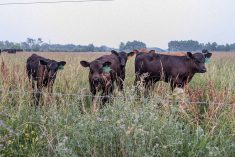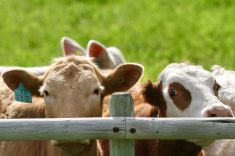PICTURE BUTTE, Alta. – At first glance, this area is a vision of tidy, prosperous looking farms surrounded by green fields of alfalfa.
But soon, the smell of pungent manure from intensive livestock operations surrounding this southern Alberta community mars the pastoral vision.
The smell of manure is so overpowering that some locals don’t care about the prosperity these farms bring.
“There’s no control over the odor,” said Ann Baran of Turin. “You drive into Picture Butte and it’s absolutely nauseating.”
She raised her voice during a public meeting to discuss a regional health authority proposal to stop further development of intensive livestock operations in the County of Lethbridge.
Read Also

U.S. farm group supports supply management
U.S. grassroots farm advocacy group pushing new agriculture legislation that would move towards supply management like Canada has for dairy industry
Health and government officials conceded expansion happened too quickly and efforts to educate farmers about proper manure handling are slow to take root.
“Unfortunately, we may be behind the curve on this,” said Ron Axelson, manager of the Alberta Cattle Feeders Association. “The concentration of animals and people and the crud they leave behind has to have an impact on the environment.”
With 450 intensive livestock operations, the County of Lethbridge has the highest concentration of feedlots, piggeries, dairies and poultry farms in Canada.
The recent announcement that a Taiwanese hog processor plans to kill two million hogs a year in Lethbridge has many questioning the impact the project could have on quality of life.
And the expansion plans do not stop with the hog plant.
Permits granted
Since Jan. 1, the county has issued 14 building permits that allow another 53,500 beef cattle into feedlots, one permit for a 150 farrow-to-weaning operation and two permits totalling 270 dairy cows. Another permit for 4,000- feeder pigs is pending.
Debate in this county mirrors concerns being heard across the Prairies as the livestock industry grows. The rapid expansion of the hog industry has created more alarm than any other form of intensive livestock production. The biggest issue is smell from the barns, storage lagoons and manure spreading.
While governments and developers across the Prairies promote the economic benefits of industrial-scale hog farms housing upwards of 4,000 sows, neighbors hold their noses and say, “not in my backyard.”
Connie Osterman farms east of Carstairs and is part of the County of Mountainview agriculture planning group. She is one who holds her nose.
This group of about 25 central Alberta farmers successfully pressured their municipality to reject a building permit for a 4,000 sow operation this spring. The Pig Improvement Canada operation moved to the Drumheller area.
Now, the planning group is working with the county to improve bylaws governing these developments. They’re worried many municipalities don’t have the staff expertise to review applications properly.
“We don’t want to put up roadblocks, but do we want them in business at any cost?” asks Osterman.
In Alberta, municipalities rely on a code of practice for animal manure handling. It was revised in 1995 by a committee of producers, government representatives from agriculture, environment, health, municipal affairs and the farmer’s advocate.
It is intended for producers, municipalities, land use planners and others concerned about management of expanding livestock facilities.
Osterman and other critics say the code was written for smaller farms and may not work for huge operations.
“It’s like taking the regulations that you use to govern a country abattoir and using them to govern a Cargill,” said Osterman. “It just can’t work.”
Hog farmer and developer Gary Shaw, of Lacombe, knows the other side of the debate. He has seen firsthand what happens when someone wants to expand or build a new hog farm.
As president of Alberta Pig Company, he strongly advises building far away from people.
“As the developer, you have to do your homework,” he said. “You have to do a lot more testing, you have to get engineers’ reports. You have to do all of those things as part of that development that weren’t required before.”
Cost of doing business
It can be costly but he said developers should not complain.
“Environmentally sustainable agriculture is what this is all about. It becomes onerous at times for developers, but it is a reality and we just have to live with it,” said Shaw.
One of the first steps is visiting the municipal development officer to learn local rules.
“There is no consistency,” he said. “It would make it easier for development if there was some consistency amongst the municipalities across the board as to what the requirements are.”
He suggested a community meeting with neighbors to explain exactly what kind of farm is proposed.
But even when a developer has done all the homework, getting approval for a building permit is not assured. “You better realize you more than likely will be at a development appeal hearing,” said Shaw.
Challenges are based on possible bacterial contamination of water supplies, heavy metals residue or dust from traffic. Yet the real issue is the smell of manure. If enough ratepayers complain, local politicians will reject a permit because it is politically safe, he said.
More land needed
To get around this, many developers are building multi-site operations to spread the manure over a larger land base. The farm may have weaner pigs on one operation, farrowing on another site and finishing barns elsewhere.
His company is building at Wainwright. Farrowing and weaning are based on one quarter of land and the 16 finisher barns will be placed on independent sites.
Bernie Kotelko, president of the Alberta Cattle Feeders Association and partner in a 25,000 head feedlot at Vegreville, said the government and the farm community are setting up a strategic plan for intensive livestock expansion in Alberta.
It can be an emotional issue. Farmers have to get along with neighbors before applying for a development permit and must mend fences both figuratively and literally before proceeding.
“If there’s a fence you didn’t fix for the last 10 years along some adjoining property, you better fix it first,” said Kotelko.
In Saskatchewan and Manitoba, building and environmental regulations are under provincial control while Alberta and British Columbia focus on local approval.
All provinces expect a developer to meet specific requirements for separating the farm site from neighbors, handling waste and use of water.
“Our biggest advice to producers is to do a lot of pre-planning and try to anticipate all the environmental and social impacts they can,” said Marvin Salomons, of Alberta Agriculture.















